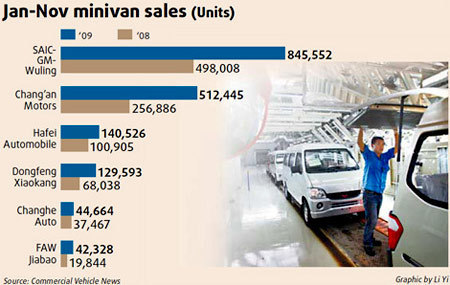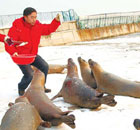Top Biz News
Subsidies drive sales of minivans
By Li Fangfang (China Daily)
Updated: 2010-01-11 07:58
 |
Large Medium Small |

Having witnessed the results of last years' rural auto sales on the back of the stimulus package, the central government decided in December that China would extend the measures until Dec 31, 2010, with small adjustments, to further support the world's biggest and fastest-growing vehicle market.
The purchase tax for smaller cars will be lifted slightly from the current 5 percent to 7.5 percent of the total vehicle price.
Furthermore, the government also decided to raise the subsidy for trade-in cars from between 3,000 and 6,000 yuan in 2009 to between 5,000 yuan and 18,000 yuan per vehicle this year.
"The revised policy with subsidies increased on such a big scale will definitely boost the new vehicle sales this year, because the almost 20,000 yuan subsidy for trade-in will attract more old vehicle owners to replace their outdated motors," said Jia Xinguang, an independent auto analyst based in Beijing.
"More significantly, the policy which encourages people to replace outdated vehicles with high emissions and unstable driving performances will contribute more to China's appeal for a high fuel-efficiency and low-emission green society forwhich the automobile industry shoulders heavy responsibility," said Yale Zhang, director of Greater China Vehicle Forecasts for the US auto industry consultancy CSM Worldwide.
Win-win situation
The stimulus measures helping farmers to buy vehicles not only lifted the living standard for rural residents, but also boosted business for automakers across the country.
"It's especially favorable for China's homegrown auto brands which provide relatively low price vehicles," said analyst Jia.
Central China's Anhui province, where many domestic automakers, such as Chery and JAC are located, has been one of the regions to benefit most in the auto sales promotion campaign last year.
Official statistics show that in the first nine months, the province sold more than 137,000 vehicles to rural residents, with a total revenue of 4 billion yuan and government subsidies of 180 million yuan.
Driven by the favorable policies, the total vehicle sales in Anhui province are expected to exceed 800,000, bringing the sales revenue close to 100 billion yuan.
Last month, SAIC-GM-Wuling, GM China's mini-commercial vehicle joint venture with SAIC and Wuling Motors, announced that it had become the first Chinese automaker to sell 1 million vehicles in a single calendar year with a year-on-year increase from 2008 of 63.9 percent to 1.06 million units.
It is on track to remain China's mini-commercial vehicle sales champion for a fourth consecutive year.
The Wuling brand was also the first domestic vehicle nameplate to achieve annual sales of 1 million units. With sales of 596,630 units, the Wuling Sunshine, a popular minivan in China's rural regions, set a Chinese industry record for annual sales of a single model.
"One of the primary reasons for our record sales is the Chinese government stimulus policy, which is encouraging rural residents to upgrade from farm vehicles to more efficient mini-vehicles," said Yang Jie, general manager of SAIC-GM-Wuling Sales Co.
By the end of last year, the venture had expanded its sales and service network with 1,300 dealerships, covering 90 percent of cities and 30 percent of counties in China.
Wang Guanwei, a rural resident living in Hexi village, Linshu county, Shandong province, said that in his village, more than 80 percent of the minivans were Wuling branded.
By acquiring the Changhe and Hafei brands in November, in the first 11 months Chang'an Motors sold 725,000 minivans, taking second place to SAIC-GM-Wuling in the sector.
"In December, we sold more than 3,000 vehicles a day, which indicated a robust demand from the domestic market," said Yang Dayong, vice-marketing director of Chang'an Motors. "The strong demand will definitely continue in 2010."
The robust growth has turned Chang'an's financial performance from losses into gains from the third quarter last year. It reported a net profit of 309 million yuan in the third quarter, compared with a net loss of 107 million yuan for the same period in 2008.













